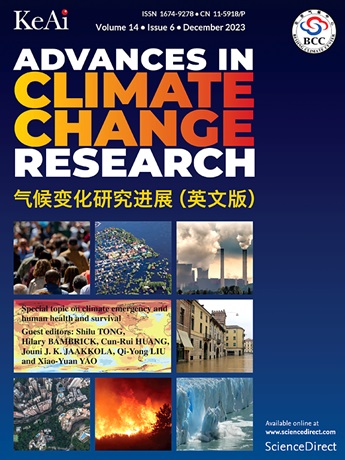Future changes in population exposure to intensified heatwaves over three major urban agglomerations in China based on excess heat factor
IF 5.2
1区 地球科学
Q1 ENVIRONMENTAL SCIENCES
引用次数: 0
Abstract
Heatwave events (HWs) have become more frequent and intense due to climate change and urbanization, posing risks to human health, yet the influence of rapid temperature fluctuation on human adaptation during these events remains insufficiently explored. This study identified HWs and estimated population exposure across three major urban agglomerations in eastern China based on the Excess Heat Factor (EHF), which accounts for the superposed effect of extreme heat and human adaptability in response to rapid temperature fluctuations. From 1961 to 2022, the Beijing–Tianjin–Hebei (BTH) region and Guangdong–Hong Kong–Macao Greater Bay Area (GBA) suffered from moderate HWs with higher frequency and shorter duration, while HWs in the Yangtze River Delta (YRD) region were characterized by lower frequency and longer duration. Compared to EHF, the conventional approach that uses single temperature criteria to identify HWs tends to underestimate their intensity without accounting for the effects of sudden temperature rises on human adaptability. Based on the downscaled ensemble of 23 models from the Coupled Model Intercomparison Project Phase 6 (CMIP6), HWs and population exposure are expected to increase across the three urban agglomerations in the near-term (2025–2035) and mid-term (2055–2065) future, with GBA experiencing the greatest rise in HW days. However, YRD will have the highest population exposure due to its large population. During the projected explosive growth of severe/extreme HW days, low and intermediate GHG emission scenarios (SSP1-2.6, SSP2-4.5) could potentially avoid 29%/45%, 28%/42% and 44%/96% of the increase in population exposure to these events across the BTH, YRD, and GBA, respectively, in the mid-term future, compared to high GHG emission scenarios (SSP3-7.0, SSP5-8.5). Further analysis reveals that the expected increase in HWs in GBA and BTH is attributable to the combined effect of intensified temperature variability and warming, while the changes in HWs in YRD are primarily driven by rising temperatures. The results emphasize the urgent need to develop resilience to HWs in a changing climate.
基于余热因子的中国三大城市群人口暴露于强热浪的未来变化
由于气候变化和城市化,热浪事件(HWs)变得更加频繁和强烈,对人类健康构成风险,但在这些事件期间,温度快速波动对人类适应的影响仍未得到充分探讨。本研究基于余热因子(EHF)确定了中国东部三个主要城市群的HWs并估计了人口暴露,该因子考虑了极端高温和人类对快速温度波动的适应性的叠加效应。1961 - 2022年,京津冀和粤港澳大湾区(GBA)地区出现中度高强度强降水,频率较高,持续时间较短;长三角地区出现低强度强降水,持续时间较长。与EHF相比,使用单一温度标准来识别hhf的传统方法往往低估了它们的强度,而没有考虑温度突然上升对人类适应能力的影响。基于耦合模式比对项目第6阶段(CMIP6)的23个模式的缩小集合,预计三个城市群在近期(2025-2035年)和中期(2055-2065年)的HW和人口暴露将增加,其中大湾区的HW天数增幅最大。然而,由于人口众多,长三角的人口暴露率最高。与高排放情景(SSP3-7.0、SSP5-8.5)相比,低排放情景(SSP1-2.6、SSP2-4.5)和中排放情景(SSP1-2.6、SSP2-4.5)在未来中期可能分别避免长江三角洲、长三角洲和大湾区人口暴露增加的29%/45%、28%/42%和44%/96%。进一步分析表明,大湾区和BTH的HWs预期增加是温度变率加剧和增温的共同作用,而长三角的HWs变化主要是由温度上升驱动的。研究结果强调了在不断变化的气候条件下,迫切需要发展对高热量食物的抵御能力。
本文章由计算机程序翻译,如有差异,请以英文原文为准。
求助全文
约1分钟内获得全文
求助全文
来源期刊

Advances in Climate Change Research
Earth and Planetary Sciences-Atmospheric Science
CiteScore
9.80
自引率
4.10%
发文量
424
审稿时长
107 days
期刊介绍:
Advances in Climate Change Research publishes scientific research and analyses on climate change and the interactions of climate change with society. This journal encompasses basic science and economic, social, and policy research, including studies on mitigation and adaptation to climate change.
Advances in Climate Change Research attempts to promote research in climate change and provide an impetus for the application of research achievements in numerous aspects, such as socioeconomic sustainable development, responses to the adaptation and mitigation of climate change, diplomatic negotiations of climate and environment policies, and the protection and exploitation of natural resources.
 求助内容:
求助内容: 应助结果提醒方式:
应助结果提醒方式:


